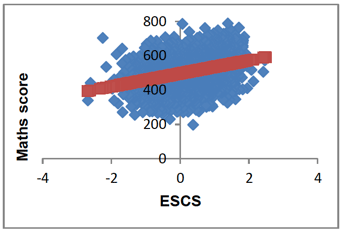Programme for International Student Assessment (PISA) 2018: highlights from Scotland's results
Report covering Scotland's performance in the Programme for International Student Assessment (PISA) 2018, covering reading, maths and science.
3. How results are displayed in this report
3.1 What measures are used
Statistical Significance – This report shows results divided into those countries whose scores are statistically significantly higher than, similar to or lower than Scotland. By "significant" we mean that we are 95 per cent certain that there is a difference (or similarity).
Throughout this report, if one result is described as 'higher' than another, it means it is statistically significantly higher. If there is no statistically significant difference between results they are described as 'similar' and if one result is described as 'lower' than another, it means it is statistically significantly lower.
Link Error – For most of the year on year comparisons in this report, a link error is applied to tests for statistical significance. The OECD provide this to quantify the uncertainty when comparing scores over different waves of data (e.g. 2018 v 2015).
In this report, the link error is important when comparing 2018 reading results with 2003 reading results. From Chart 4.1.1 it appears as though 2003 reading results are statistically significantly higher than 2018 reading results, but due to a large link error between 2003 and 2018, the results are statistically similar.
Mean PISA score – this is the overall PISA score and is the main result used to assess how Scotland's education system is performing. Mean PISA score can be calculated for different characteristics (e.g. gender, immigration background and ESCS group).
Standard Deviation – this is a measure of the spread of the results within a country. A higher standard deviation indicates more variation in the results (i.e. a larger proportion of pupils have a PISA score that is further away from the mean).
Gender – results are generally broken down to show differences between girls and boys and trends of girls and boys over time.
Immigration background – results are broken down by immigration background. The OECD define second generation immigrants as students where one or both parents were born in another country (i.e. not in the UK). First generation immigrants are where the student was born in another country (i.e. not in the UK). Non-immigrants are where the student and both parents were born in the UK.
Proficiency Levels – PISA scores can be grouped into different PISA Levels. It is common to look at the proportion of students performing below PISA Level 2 and at PISA level 5 or better. The group below Level 2 merits particular attention, as the OECD consider that Level 2 is the baseline of ability to participate effectively in society.
ESCS - The OECD analyse social background using the Index of Economic, Social and Cultural Status (ESCS). It is constructed from the responses given by students in their background questionnaire and collects information on parental education and occupation, learning resources in the home and cultural possessions. This index is not comparable to the measure commonly used in Scotland - the Scottish Index of Multiple Deprivation (SIMD). There are two main reasons for this:
1. SIMD is exclusive to Scotland, while ESCS is recorded for all participating countries in PISA. This enables comparative analysis between countries.
2. SIMD is an area based measure, with pupils being allocated to datazones based on their postcode. We talk about pupils living in the '20% most deprived areas' when referring to SIMD. ESCS is generated directly from information provided by the student on their own background, rather than it being based on their home address. This means it avoids issues of more affluent students being resident in areas which are disadvantaged, and vice versa.
The ESCS index is used to derive a number of measures, each of which tell us something different about the impact of social background on performance.
The percentage share of the variation in performance explained by social background tells us how strong the relationship is between student performance and ESCS. For example, we can see an illustration of Scotland's students' scores in maths for 2012 plotted against the ESCS on the bottom. In 2012, 12.9 per cent of the variation in maths score was explained by social background, and in fact it is possible to see that many students from less affluent backgrounds (towards the left of the graph) achieved high marks - outperforming the average for their circumstances, and vice versa.

The ESCS gradient, shows simply how much score varies on average with each step (one point) in social background and can be seen by the slope of the line on the graph. Despite many students "bucking the trend", there is still a positive relationship between affluence and performance in PISA overall. For maths in 2012, this was a gradient of 37 score points. A higher score would indicate a steeper gradient, and greater increases in score with background prosperity.
The length of the gradient looks at the students on the 5th and 95th percentiles to ensure that the very extremes of wealth and poverty don't distort the comparison. In Scotland these two notional students were 2.6 points apart by social background measured by ESCS in 2012.
With a gradient of 37 score points, this implies a difference in their maths performance of 96 score points. Although translating this gap into school years of education is not straightforward, the OECD calculate that this could imply as much as three years' difference in learning achievement (with 30 points being equivalent to a year. Note that this measure depends on the size of the gap in society as well as the gap in education ability.
Contact
Email: keith.dryburgh@gov.scot
There is a problem
Thanks for your feedback